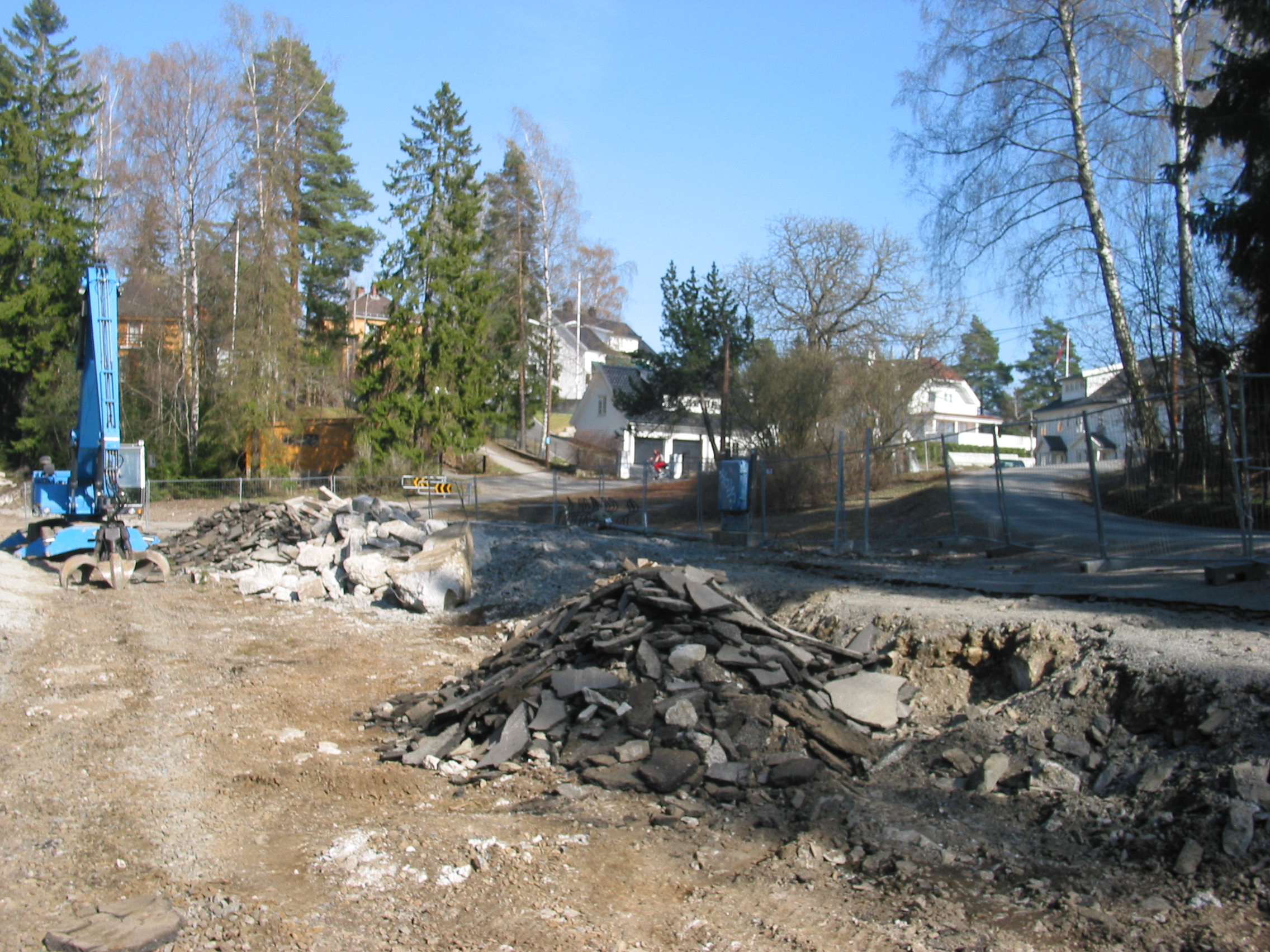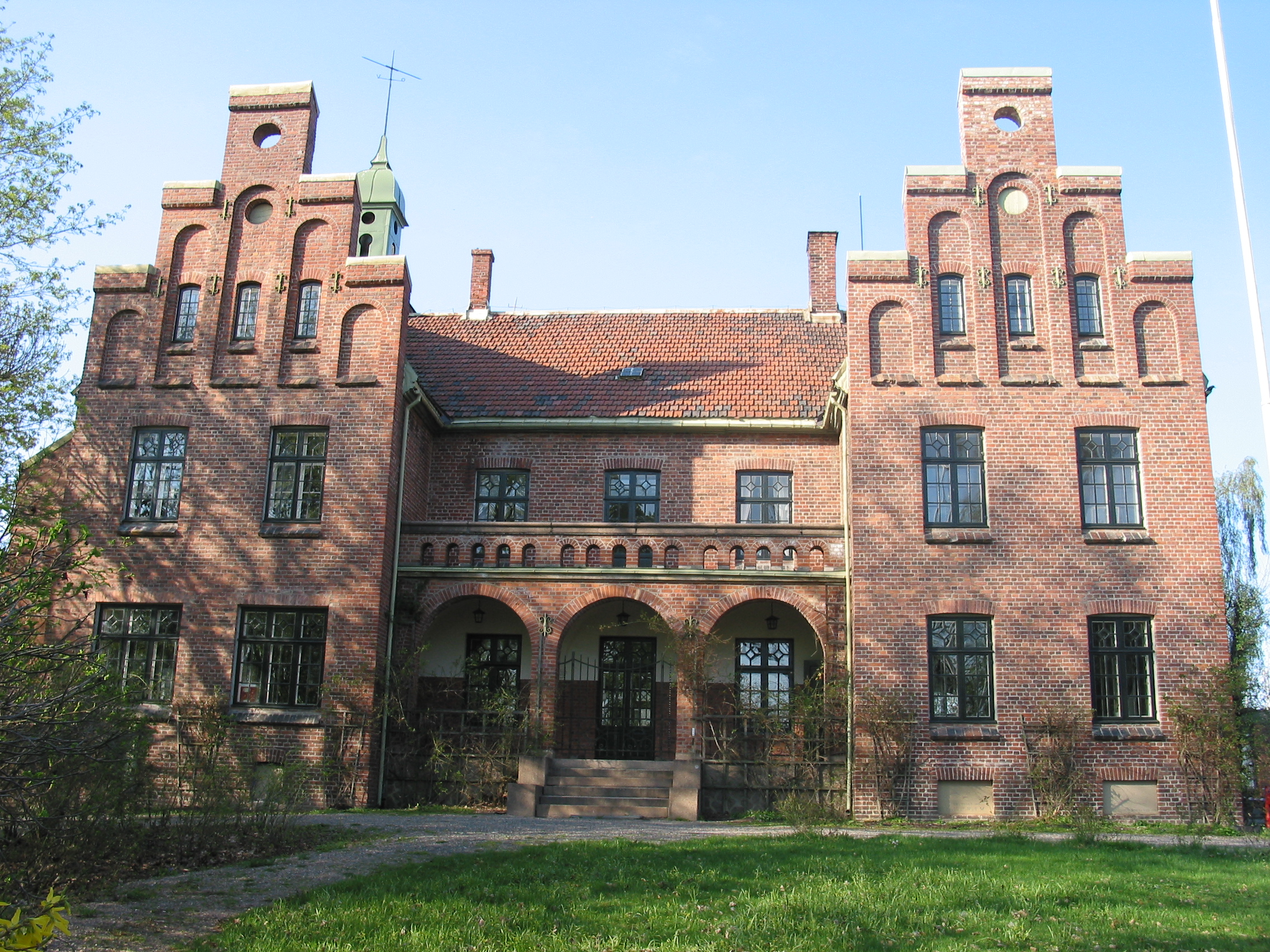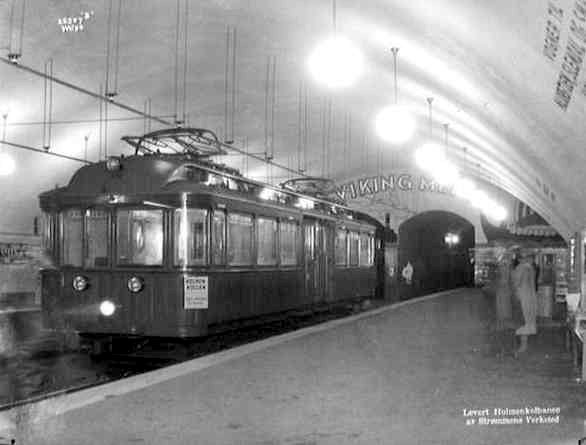|
Ringstabekk (new Station)
Ringstabekk is a station on the Kolsås Line (line 2) on the Oslo Metro system. Located in Bærum, Norway, it is between Bekkestua and Jar, 10.2 km west of Stortinget. The station opened on 15 August 2011 and replaces the former station with the same name and Tjernsrud as part of the upgrade of the Kolsås Line to metro standard. The station is located at the section of the line where it is shared with the Lilleaker Line used by the Oslo Tramway The Oslo tram network ( no, Trikken i Oslo, short from ', 'electric') is the tram system in Oslo, Norway. It consists of six lines with 99 stops and has a daily ridership of 132,000. It is operated by , a subsidiary of the municipally-owned who .... However, due to lack of dedicated low-height platforms, trams do not stop at this station. References External links Oslo Metro stations in Bærum Railway stations opened in 2011 2011 establishments in Norway Railway stations in Norway opened in the 2010s {{Oslo-m ... [...More Info...] [...Related Items...] OR: [Wikipedia] [Google] [Baidu] |
OSLO T-bane Orange Icon
Oslo ( , , or ; sma, Oslove) is the capital and most populous city of Norway. It constitutes both a county and a municipality. The municipality of Oslo had a population of in 2022, while the city's greater urban area had a population of in 2019, and the metropolitan area had an estimated population of in 2021. During the Viking Age the area was part of Viken. Oslo was founded as a city at the end of the Viking Age in 1040 under the name Ánslo, and established as a ''kaupstad'' or trading place in 1048 by Harald Hardrada. The city was elevated to a bishopric in 1070 and a capital under Haakon V of Norway around 1300. Personal unions with Denmark from 1397 to 1523 and again from 1536 to 1814 reduced its influence. After being destroyed by a fire in 1624, during the reign of King Christian IV, a new city was built closer to Akershus Fortress and named Christiania in honour of the king. It became a municipality ('' formannskapsdistrikt'') on 1 January 1838. The city fu ... [...More Info...] [...Related Items...] OR: [Wikipedia] [Google] [Baidu] |
Bekkestua (station)
Bekkestua is a station and tram stop that is served both by Oslo Metro on Kolsås Line and Oslo Tramway on Lilleaker Line situated at Bekkestua in Bærum, Norway. It is the terminus of the Lilleaker Line for tramway. Located between Ringstabekk (new station), Ringstabekk and Gjønnes (station), Gjønnes, it was reopened on 15 August 2011 after being closed on 1 July 2006. Between 1 July 2003 and November 2004, Bekkestua was the end station on the Kolsås Line. For a while the station was only being served by the Oslo Tramway line 13, while the station was closed for an upgrade. Since 2 December 2007, tram operations (on line 13) have returned on this line from Lilleaker to Bekkestua. Operations beyond Lilleaker use SL95 trams as there is no turnback loop at Bekkestua. The tram operations were discontinued in 2009, but reopened in January 2014 after technical difficulties delayed the opening by one month. Bekkestua bus terminal is only a minute's walk from the metro and tram platf ... [...More Info...] [...Related Items...] OR: [Wikipedia] [Google] [Baidu] |
Railway Stations Opened In 2011
Rail transport (also known as train transport) is a means of transport that transfers passengers and goods on wheeled vehicles running on rails, which are incorporated in tracks. In contrast to road transport, where the vehicles run on a prepared flat surface, rail vehicles (rolling stock) are directionally guided by the tracks on which they run. Tracks usually consist of steel rails, installed on sleepers (ties) set in ballast, on which the rolling stock, usually fitted with metal wheels, moves. Other variations are also possible, such as "slab track", in which the rails are fastened to a concrete foundation resting on a prepared subsurface. Rolling stock in a rail transport system generally encounters lower frictional resistance than rubber-tyred road vehicles, so passenger and freight cars (carriages and wagons) can be coupled into longer trains. The operation is carried out by a railway company, providing transport between train stations or freight customer facilit ... [...More Info...] [...Related Items...] OR: [Wikipedia] [Google] [Baidu] |
Oslo Metro Stations In Bærum
Oslo ( , , or ; sma, Oslove) is the capital and most populous city of Norway. It constitutes both a county and a municipality. The municipality of Oslo had a population of in 2022, while the city's greater urban area had a population of in 2019, and the metropolitan area had an estimated population of in 2021. During the Viking Age the area was part of Viken. Oslo was founded as a city at the end of the Viking Age in 1040 under the name Ánslo, and established as a ''kaupstad'' or trading place in 1048 by Harald Hardrada. The city was elevated to a bishopric in 1070 and a capital under Haakon V of Norway around 1300. Personal unions with Denmark from 1397 to 1523 and again from 1536 to 1814 reduced its influence. After being destroyed by a fire in 1624, during the reign of King Christian IV, a new city was built closer to Akershus Fortress and named Christiania in honour of the king. It became a municipality ('' formannskapsdistrikt'') on 1 January 1838. The city fu ... [...More Info...] [...Related Items...] OR: [Wikipedia] [Google] [Baidu] |
Oslo Tramway
The Oslo tram network ( no, Trikken i Oslo, short from ', 'electric') is the tram system in Oslo, Norway. It consists of six lines with 99 stops and has a daily ridership of 132,000. It is operated by , a subsidiary of the municipally-owned who maintain the track and 72 tram vehicles on contracts with the public transport authority . The system operates on standard gauge and uses 750 V DC overhead. Depot, workshops and headquarters are at (at the terminus of lines 13 and 17). There is also a depot at (along lines 18 and 19) that is home to the technical company InfraPartner, which maintains the track for the tram and metro systems in Oslo, and a small office building for . History The first tram in Oslo was opened in 1875 with a short line between Homansbyen west of the city centre, Oslo West Railway Station and a sideline to Grønland, east of the city centre. The first "trams" were in fact horse-drawn vehicles on flanged steel wheels. The first expansion of the line came ... [...More Info...] [...Related Items...] OR: [Wikipedia] [Google] [Baidu] |
Lilleaker Line
The Lilleaker Line ( no, Lilleakerbanen) is a suburban tramway from Skøyen in Oslo westwards to Jar, Bærum in Norway. It is operated by Line 13 from Ljabru to Bekkestua of the Oslo Tramway, operated by Oslo Sporvognsdrift. The line continues on the Oslo Metro west of Jar as part of the Kolsås Line, and as a street tramway on the Oslo tramway system at Skøyen as the Skøyen Line. Route The Lilleaker Line runs from Skøyen to Jar. The line is a standard gauge, double track light rail line with 750 volt overhead wire. At Skøyen it connects with the Skøyen Line of the Oslo Tramway and at Jar to the Kolsås Line of the Oslo Metro. Most of the route is dominated by housing. At Skøyen, there is a short walk to Skøyen Station on the mainline Drammen Line. It serves all west-bound trains of the Oslo Commuter Rail, some regional trains and the Airport Express Train. The station is also an important bus hub serving several routes. The route continues via Hoff and Abbdedie ... [...More Info...] [...Related Items...] OR: [Wikipedia] [Google] [Baidu] |
Tjernsrud (station)
Tjernsrud was a station on the Kolsås Line (line 6, now Line 3) on the Oslo Metro system. Located in Bærum, Norway, it was between Ringstabekk and Jar, 9.9 km west of Stortinget. It served the neighborhoods of northern Stabekk and southeastern Jar. The station was opened on 1 July 1924 as part of the tramway Bærum Line. Along with most of the line, Tjernsrud was closed for upgrades since 1 July 2006. From August 2007 its service was temporarily provided by tram line 13, as an extension of the service from Jar to Bekkestua. It was decided not to reopen Tjernsrud as a metro station, and as the tram service ended in February 2009, it was demolished soon after. The company responsible for public transport in Oslo, Ruter, has the long-term objective of opening the Kolsås Line The Kolsås Line ( no, Kolsåsbanen) is a line of the Oslo Metro. It branches off from the Røa Line at Smestad Station and runs through western Oslo and Bærum to Kolsås Station. It serves the n ... [...More Info...] [...Related Items...] OR: [Wikipedia] [Google] [Baidu] |
Ringstabekk (old Station)
Ringstabekk is a district in Bærum, Norway. Named after the local farm, the district is also known for its schools and the sports field. The sports club Stabæk IF originates in the area. The farm The district originates from the farm Øvre Stabæk ('Upper Stabæk'), one of several farms in the Stabekk area. Antiquities from ancient times, such as axes and arrowheads, have been found there. The farm was owned by Hovedøya Monastery before the Reformation of 1536, and thereafter by the Crown. In 1661 it was registered with a private owner, and a series of owners followed until Jens Ring bought the farm in 1839. The farm was renamed Ring-Stabekk, or Ringstabekk, after Jens Ring. In 1826 it had been registered with three horses, ten cattle and twelve sheep. In 1851 Jens Ring was behind the construction of "The Castle", a Neogothic brick building, drawn by architect Heinrich Ernst Schirmer. The Castle was a center of bourgeois social life until Ring's death in 1874. The property was ... [...More Info...] [...Related Items...] OR: [Wikipedia] [Google] [Baidu] |
Jar (station)
Jar is a station served both by the Oslo Metro and the Oslo Tramway located in Bærum, just west of Lysakerelva which divides Oslo and Bærum. The track is shared, the tram line (Lilleaker Line) joins with the rapid transit line (Kolsås Line) on the Oslo side of the river. The station's penthouse is yellow and contained a newspaper outlet. Formerly, the entire line to Kolsås was part of the tram network. Jar was originally a terminus for the defunct line 10, and had a balloon loop. However, this has been removed and since the 2nd of December 2007, tram operations (line 13) have returned on this line from Jar to Bekkestua Bekkestua is a town in the municipality of Bærum, Norway, with a busy bus terminal and a station on one of Oslo's westbound T-bane lines, Kolsåsbanen. It also has its own library, police station and fire station. It has grown to be the second .... As of December 2016, the Tram line 13 is running trams (every 20 minutes, 15 at weekends.) to Bekkestua. Th ... [...More Info...] [...Related Items...] OR: [Wikipedia] [Google] [Baidu] |
Oslo Metro
The Oslo Metro ( no, Oslo T-bane or or simply ) is the rapid transit system of Oslo, Norway, operated by Sporveien T-banen on contract from the transit authority Ruter. The network consists of five lines that all run through the city centre, with a total length of , serving 101 stations of which 17 are underground or indoors. In addition to serving 14 out of the 15 boroughs of Oslo, two lines run to Kolsås and Østerås, in the neighboring municipality of Bærum. In 2016, the system had an annual ridership of 118 million. The first rapid transit line, the Holmenkollen Line, opened in 1898, with the branch Røa Line opening in 1912. It became the first Nordic underground rapid transit system in 1928, when the underground line to Nationaltheatret was opened. After 1993 trains ran under the city between the eastern and western networks in the Common Tunnel, followed by the 2006 opening of the Ring Line. All the trains are operated with MX3000 stock. These replaced the older T100 ... [...More Info...] [...Related Items...] OR: [Wikipedia] [Google] [Baidu] |
Ringstabekk
Ringstabekk is a district in Bærum, Norway. Named after the local farm, the district is also known for its schools and the sports field. The sports club Stabæk IF originates in the area. The farm The district originates from the farm Øvre Stabæk ('Upper Stabæk'), one of several farms in the Stabekk area. Antiquities from ancient times, such as axes and arrowheads, have been found there. The farm was owned by Hovedøya Monastery before the Reformation of 1536, and thereafter by the Crown. In 1661 it was registered with a private owner, and a series of owners followed until Jens Ring bought the farm in 1839. The farm was renamed Ring-Stabekk, or Ringstabekk, after Jens Ring. In 1826 it had been registered with three horses, ten cattle and twelve sheep. In 1851 Jens Ring was behind the construction of "The Castle", a Neogothic brick building, drawn by architect Heinrich Ernst Schirmer. The Castle was a center of bourgeois social life until Ring's death in 1874. The property was ... [...More Info...] [...Related Items...] OR: [Wikipedia] [Google] [Baidu] |
Rapid Transit Station
A metro station or subway station is a station for a rapid transit system, which as a whole is usually called a "metro" or "subway". A station provides a means for passengers to purchase tickets, board trains, and evacuate the system in the case of an emergency. In the United Kingdom, they are known as underground stations, most commonly used in reference to the London Underground. Location The location of a metro station is carefully planned to provide easy access to important urban facilities such as roads, commercial centres, major buildings and other transport nodes. Most stations are located underground, with entrances/exits leading up to ground or street level. The bulk of the station is typically positioned under land reserved for public thoroughfares or parks. Placing the station underground reduces the outside area occupied by the station, allowing vehicles and pedestrians to continue using the ground-level area in a similar way as before the station's constructio ... [...More Info...] [...Related Items...] OR: [Wikipedia] [Google] [Baidu] |








